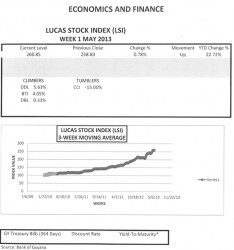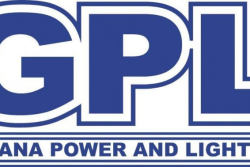Upbeat news
In the space of two days, Guyanese got a series of upbeat news about the economy. In a Stabroek News article of May 7, 2013, it was reported that the International Monetary Fund (IMF) predicted that the economy would grow by about 5.5 per cent during 2013. On the same day it was also reported that the Latin American Public Opinion Project (LAPOP) found that more than two-thirds of the country had an upbeat view of life in Guyana. Then one day later the Georgetown Chamber of Commerce and Industry (GCCI) disclosed the results of its second Attitudinal Survey taken among the membership of the organization. The most prominent disclosure was that 91 per cent of the membership of the GCCI reported earning a profit in 2012. The survey also revealed that over 80 per cent of its membership anticipates the economy to remain strong while 71 per cent of respondents believe that they will record even higher revenues this year. Two of the results were derived from opinion surveys while the other was garnered from a substantive analysis of the key variables of the economy by an organization that enjoys credibility, if not the full confidence of Guyanese. In a way, the two opinions that originated from foreign sources could be interpreted as validating the findings of the local GCCI organization. The Guyana economy has been doing well and gives rise to two questions. One is what is responsible for the consistent growth of the Guyana economy? And two, can this growth be sustained by widening current account deficits which seems to be a major contributing factor to growth? A word of caution might be needed before the popping of the champagne.
To each his own
Before seeking to address the two questions, an observation about the LAPOP satisfaction survey is important. While it is good to know that Guyanese are satisfied with their lives, the LAPOP survey might also be saying something about the quality of life that Guyanese are prepared to accept. Many would be amazed to know that Guyanese are satisfied with a standard of living that includes a filthy city and its environs with decaying garbage all around them. It is amazing too that they are satisfied with drains, gutters and canals that are clogged with bush and rubbish, and give off horrible odour. Eye-brows would be raised to know that streets that flood from the slightest rainfall and vehicle maintenance, high from dilapidated roads, engender high levels of satisfaction. It is stunning that Guyanese are satisfied with wild and disorderly vehicular traffic, unprofessional police conduct, a broken judicial system and the wanton abuse of women and children. The standards that Guyanese have set for themselves seem rather low and might be a major reason that they could be satisfied with the state of affairs in the country. One could only be dumbfounded by that reality and what it says about the standards of the nation.
Consistency

The observations from the three sets of diverse sources follow the annual reporting in the budget presentation that pointed out that the economy has been growing, albeit at varying rates, for the past seven years. The data show that the growth rate of the economy has been above four per cent five of the seven years from 2006 to 2012. The consistency with which the economy has been growing might be the result of factors beyond the policy tools of the administration. This writer, in previous articles, has cited the world price of gold and hence the significant investment in the industry along with the high levels of remittances as important contributors to the sustained growth outcomes over the years. None of the two variables is beneficiaries of any unique policy measures by the administration.
Slower pace
Adjusting for gold and even for the poor-performing sugar industry, the economy still grows albeit at a much slower pace than with all industries considered. A review of the balance-of-payments reveals that Guyana is running significant trade deficits. Ever since 2006, the trade deficit has been greater than 50 per cent of the value of Guyana’s export receipts. In the five years prior, from 2001 to 2005, the trade deficit was on average less than 20 per cent of the value of the receipts from exports. The overall current account balance has also surged when expressed as a percentage of exports, moving from an average of 21 per cent during 2001 to 2005 to 33 percent from 2006 to 2011. The deficit has widened on account of the significant expansion in imports.
Widening
The widening of the current account balance reflects an expansion of the total external capital financing available for investment in Guyana. The deficit between exports and imports gets larger when investment is greater than savings. The availability of foreign financing suggests that Guyana is able to invest more and grow faster because it is not constrained by the level of domestic savings. This is expected behaviour that stems from what is often referred to as positive productivity shock-people consume more which in turn leads to increased investment. Some research notes that growth led by current account deficits might be more the exception rather than the rule. Prasad, Rajan and Subramanian in an article entitled “The Paradox of Capital” published in the March 2007 edition of Finance and Development, a quarterly publication of the IMF, concluded that “developing countries that have relied less on foreign finance have grown faster in the long run”. In other words, countries that carried current account surpluses were able to sustain faster growth rates longer than countries that relied on current account deficits.
Least risk
From what Prasad, Rajan and Subramanian observe, the expanding current account deficit has to be offset by other inflows not to become a major concern in the long-term. The inflows with the least risk to Guyana are official development assistance and foreign direct investment. ODA in the form of funding from the development finance institutions like the World Bank and the Inter-American Develop-ment Bank is important. An important component of this assistance has been debt relief. Guyana has received debt relief on a few occasions between 2006 and 2012. Debt relief enables the country to free up revenues to spend on other things since it was no longer needed to make debt payments. The other factor is foreign direct investment. FDI has the potential to provide a broad impact on the national economy. It could increase consumption.
It could increase investment and it could increase foreign reserves. Yet, too rapid an inflow of foreign investment could lead to an appreciation of the Guyana dollar with the result that exports become expensive and uncompetitive. But, like with other developing countries, FDI has been slow to come. Prasad, Rajan and Subramanian conclude that a poorly educated labour force and corruption among other things tend to reduce the risk-adjusted return that investors receive. Yet, Guyanese seem oblivious to the reality that the very conditions which seem not to make them unhappy are the very things needed to sustain their reported happiness. Perhaps, a word of caution is needed.
The Lucas Stock Index (LSI) rose 0.78 percent in relatively light trading during the first week of trading in May 2013. A total of 98,790 stocks of six companies changed hands. Demerara Bank Limited (DBL) traded the highest number of stocks, 56,700 with a 0.33 percent increase in value. Demerara Distillers Limited (DDL) traded 16,000 with a gain of 5.63 percent. Meanwhile, Republic Bank Limited (RBL) traded 12,000 stocks for no change in value. After being dormant for a while, Caribbean Container Incorporated (CCI) traded 13,600 stocks which lost 15 percent of its value. In rather marginal trading, Demerara Tobacco Company (DTC) gave up 90 stocks with no change in value while Guyana Bank for Trade and Industry (BTI) sold 400 shares and saw the value of its stock increase by over 4 percent.









